Related Research Articles

A bus stop is a place where buses stop for passengers to get on and off the bus. The construction of bus stops tends to reflect the level of usage, where stops at busy locations may have shelters, seating, and possibly electronic passenger information systems; less busy stops may use a simple pole and flag to mark the location. Bus stops are, in some locations, clustered together into transport hubs allowing interchange between routes from nearby stops and with other public transport modes to maximise convenience.

The Auckland Harbour Bridge is an eight-lane motorway bridge over the Waitematā Harbour in Auckland, New Zealand. It joins St Marys Bay on the Auckland city side with Northcote on the North Shore side. It is part of State Highway 1 and the Auckland Northern Motorway. The bridge is operated by the NZ Transport Agency (NZTA). It is the second-longest road bridge in New Zealand, and the longest in the North Island.
Te Manatū WakaMinistry of Transport is the public service department of New Zealand charged with advising the government on transport policy. The Ministry works closely with other government transport partners, including the New Zealand Transport Agency (NZTA) to advance their strategic objectives.
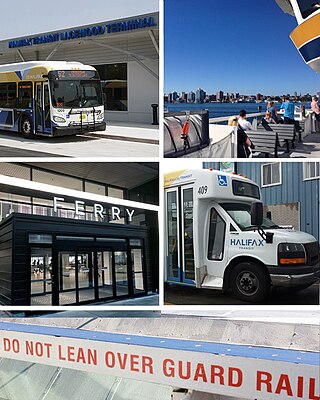
Halifax Transit is a Canadian public transport service operating buses and ferries in Halifax, Nova Scotia. Founded as Metro Transit in March 1981, the agency runs two ferry routes, 66 conventional bus routes, three regional express routes, and three rural routes. Halifax Transit also operates Access-a-Bus, a door-to-door paratransit service for senior and disabled citizens.
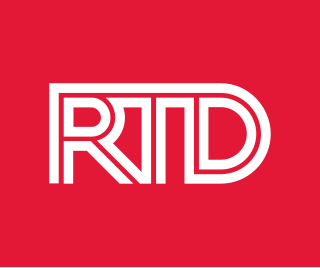
The Regional Transportation District, more commonly referred to as RTD, is the regional agency operating public transit services in eight out of the twelve counties in the Denver-Aurora-Boulder Combined Statistical Area in the U.S. state of Colorado. It operates over a 2,342-square-mile (6,070 km2) area, serving 3.08 million people. RTD was organized in 1969 and is governed by a 15-member, publicly elected Board of Directors. Directors are elected to a four-year term and represent a specific district of about 180,000 constituents.

The Southwest Ohio Regional Transit Authority (SORTA) is the public transport agency serving Cincinnati and its Ohio suburbs. SORTA operates Metro fixed-route buses, bus rapid transit, microtransit, and paratransit services. SORTA's headquarters are located at the Huntington Building in Cincinnati’s Central Business District. The agency is managed by CEO and General Manager Darryl Haley along with a 13-member board of trustees. In 2022, the system had a ridership of 9,664,000, or about 42,000 per weekday as of the third quarter of 2023.

GoRaleigh is the transit system responsible for operating most of the public transportation services in Raleigh, North Carolina. The system operates 27 fixed routes throughout the city's municipal area and also operates five regional/express routes in partnership with GoTriangle, the regional provider. GoRaleigh is contracted to operate two additional routes, an express route to the Wake Tech Community College campus south of Raleigh and a local circulator service in the Town of Wake Forest. Capital Area Transit, also known as CAT, was rebranded to GoRaleigh in 2015 under the consolidated GoTransit, a joint branding of municipal and regional transit systems for the Research Triangle. In 2022, the system had a ridership of 5,011,500, or about 15,500 per weekday as of the third quarter of 2023.

Bus priority or transit signal priority (TSP) is a name for various techniques to improve service and reduce delay for mass transit vehicles at intersections controlled by traffic signals. TSP techniques are most commonly associated with buses, but can also be used along tram/streetcar or light rail lines, especially those that mix with or conflict with general vehicular traffic.

A passenger information system, or passenger information display system, is an automated system for supplying users of public transport with information about the nature and the state of a public transport service through visual, voice or other media. It is also known as a customer information system or an operational information system. Among the information provided by such systems, a distinction can be drawn between:

A public transport timetable is a document setting out information on public transport service times. Both public timetables to assist passengers with planning a trip and internal timetables to inform employees exist. Typically, the timetable will list the times when a service is scheduled to arrive at and depart from specified locations. It may show all movements at a particular location or all movements on a particular route or for a particular stop. Traditionally this information was provided in printed form, for example as a leaflet or poster. It is now also often available in a variety of electronic formats.

In scheduled transportation, a layover is a point where a vehicle stops, with passengers possibly changing vehicles. In public transit, this typically takes a few minutes at a trip terminal. For air travel, where layovers are longer, passengers will exit the vehicle and wait in the terminal, often to board another vehicle traveling elsewhere.
In public transportation, schedule adherence or on-time performance refers to the level of success of the service remaining on the published schedule. On time performance, sometimes referred to as on time running, is normally expressed as a percentage, with a higher percentage meaning more vehicles are on time. The level of on time performance for many transport systems is a very important measure of the effectiveness of the system.
TransXChange is a UK national XML based data standard for the interchange of bus route and timetable information between bus operators, the Vehicle and Operator Services Agency, local authorities and passenger transport executives, and others involved in the provision of passenger information.
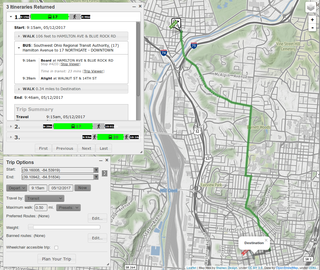
A journey planner, trip planner, or route planner is a specialized search engine used to find an optimal means of travelling between two or more given locations, sometimes using more than one transport mode. Searches may be optimized on different criteria, for example fastest, shortest, fewest changes, cheapest. They may be constrained, for example, to leave or arrive at a certain time, to avoid certain waypoints, etc. A single journey may use a sequence of several modes of transport, meaning the system may know about public transport services as well as transport networks for private transportation. Trip planning or journey planning is sometimes distinguished from route planning, which is typically thought of as using private modes of transportation such as cycling, driving, or walking, normally using a single mode at a time. Trip or journey planning, in contrast, would make use of at least one public transport mode which operates according to published schedules; given that public transport services only depart at specific times, an algorithm must therefore not only find a path to a destination, but seek to optimize it so as to minimize the waiting time incurred for each leg. In European Standards such as Transmodel, trip planning is used specifically to describe the planning of a route for a passenger, to avoid confusion with the completely separate process of planning the operational journeys to be made by public transport vehicles on which such trips are made.
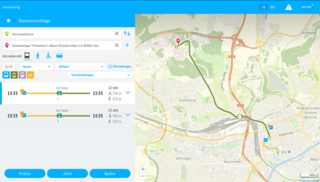
GTFS, which stands for General Transit Feed Specification or (originally) Google Transit Feed Specification, defines a common format for public transportation schedules and associated geographic information. GTFS contains only static or scheduled information about public transport services, and is sometimes known as GTFS Static or GTFS Schedule to distinguish it from the GTFS Realtime extension, which defines how information on the realtime status of services can be shared.
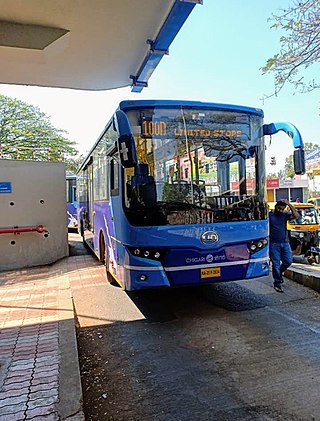
Hubli-Dharwad Bus Rapid Transit System (HDBRTS) is a bus rapid transit system built to serve the twin cities of Hubali and Dharwad, located in the North-Western part of Karnataka state in India. Hubali-Dharwad BRTS (HDBRTS) project is a Government of Karnataka initiative to foster long-term economic growth in the region. The project promotes fast, safe, comfortable, convenient and affordable public transportation between the twin cities and aims to reduce congestion and air pollution in the region.

Constellation busway station is a bus station on Auckland's Northern Busway in New Zealand. It is located near Constellation Drive in the light industrial and business area of Rosedale. It has shelters, electronic real-time information on each platform, and park and ride parking.
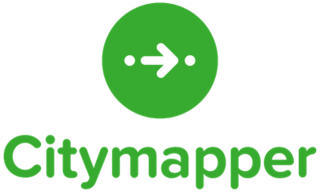
Citymapper is a public transit app and mapping service which displays transport options, usually with live timing, between any two locations in a supported city. It integrates data for all urban modes of transport, including walking, cycling and driving, in addition to public transport. It is free of charge to users, and is supported by a mobile app on devices such as mobile phones, and by an Internet website.
The North Shore Line is a proposed commuter rail or light rail line that would serve the North Shore of Auckland, New Zealand.
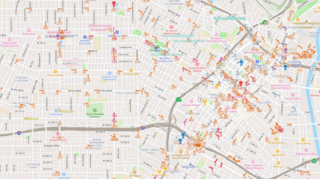
GTFS Realtime is an extension to GTFS, in which public transport agencies share real-time vehicle locations, arrival time predictions, and alerts such as detours and cancellations via Protocol Buffers web server.
References
- ↑ Ceder, Avishai (2007). Public Transport Planning and Operation: Theory, Modelling and Practice (1 ed.). p. 88. ISBN 978-0-7506-6166-9.
- ↑ "General Transit Feed Specification Reference". Google Developers. Google. Retrieved 6 June 2015.
- ↑ "Timing point bus stops". Waka Kotahi . Retrieved 15 November 2023.
- ↑ "In-lane bus stops (with bus boarders)". Waka Kotahi . Retrieved 15 November 2023.